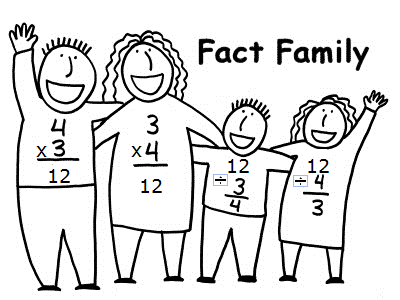Multiplication Games
Multiplication games that teach:
Fact Families

I tell my children that fact families are a great bargain! If you know one problem you can figure out the other three..so "Buy one get three free"!
How Does it Work?
First, we if we know that 2 x 3 = 6
It follows that 3 x 2 = 6
Next we can translate this into division remembering to use only the same three numbers 3, 2, and 6.
The product, 6 becomes the dividend.
The factors, 3 and 2 become the divisor and the quotient alternately.
Therefore 6 / 2 = 3 and 6 / 3 = 2
You can use egg cartons (or several cups if your in the car) to help your child understand this.
Use the seperate containers to show your child that multiplication is simply a way to count up things in groups. For example, 4 x 3 means you have four groups of three items each so you can put three beans in each of four egg cups, then count by threes to get the total. If you add another group of three, you now have 5 x 3. Every cup still has three, so it remains in the same family.
You can also use the cups/egg cartons to show division. Take a multiplication fact such as 4 x 5 = 20, put 20 items altogether and see how many equal groups you can make using all 20 items- that is division!
Crazy Math Mom Tip
It can be confusing trying to figure out how to translate a multiplication problem...so is it 4 groups of 3? OR 3 groups of 4?
To help with this you can use this sentence when you read a multiplication problem:
______rows/items of ______.
Here is how it works: If you have 4x7 you plug it into the sentence: 4 rows/items of 7. So now it is clear that you have 4 groups with 7 things in each group.
Motivating Multiplication Games:
Play:
Fact Family Go Fish
Make fact family cards. There should be 4 cards for each multiplication problem (for example: 6 x 7= ?, 7 x 6 = ? , 42 / 6 = ? , 42 / 7 = ?).
Shuffle the cards, deal seven to each player and leave the rest in the draw pile. Proceed with play as in Go Fish, trying to collect all 4 facts that make a fact family.
Shrinking Time
Make fact family cards. There should be 4 cards for each multiplication problem (for example: 6 x 7= ?, 7 x 6 = ? , 42 / 6 = ? , 42 / 7 = ?).
Ask a partner to time you as you answer each card then place it into a pile that will become that particular card's fact family. Agree on a time limit. You might start with 10 seconds per card. If you answer a card correctly within the time limit, place it in the appropriate fact family pile then, go on to the next card. If you don't know one, set the harder cards in a different pile. You now have a pile of cards to practice (use a multiplication strategy, click on : 4th Grade Multiplication). Do it again with the harder cards.
When you are able to go through the whole pile within your time limit, set a shorter time limit and repeat the steps above. Your goal is to answer each card in 3 seconds or less!
3-Minute Sort
Make fact family cards. There should be 4 cards for each multiplication problem (for example: 6 x 7= ?, 7 x 6 = ? , 42 / 6 = ? , 42 / 7 = ?).
Shuffle the cards and put 3 minutes on the clock. How many cards can you sort into fact family groups in three minutes? As you place the cards in the fact family groups shout the answer, if you are wrong or can't answer, place the card in another pile.
When the three minutes are up, count how many cards are in each pile. Can you do better?
Your child may enjoy making up more multiplication games with the cards.
Return Home from Multiplication Games
About Me Privacy Policy/Disclaimer Feedback Copyright 2024 themathhacker.com
